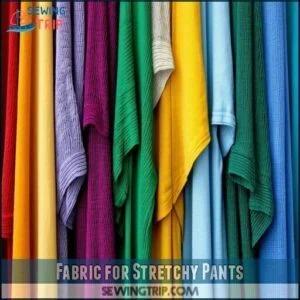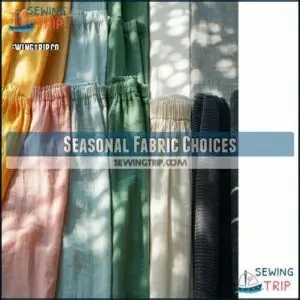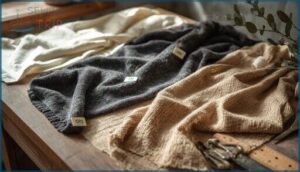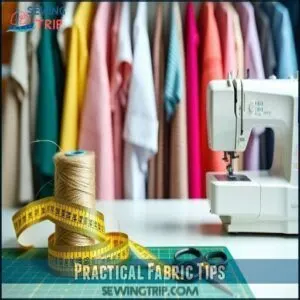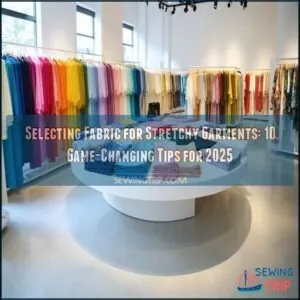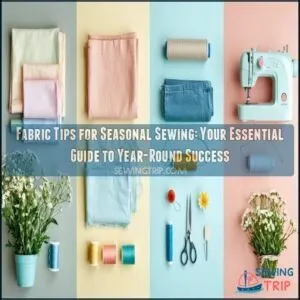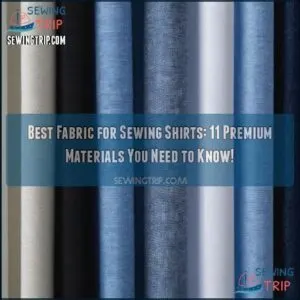This site is supported by our readers. We may earn a commission, at no cost to you, if you purchase through links.

For work pants, sturdy fabrics like twill or denim hold up well, while lighter options like linen or cotton blends are great for casual wear.
If you want stretch, look for fabrics with spandex or elastane.
Consider the season—wool works for winter, while breathable fabrics like chambray suit warmer months.
Pay attention to weight; heavier fabrics add structure, while lighter ones drape better.
Always pre-wash to avoid surprises later.
The right fabric can make or break your project, so choose wisely and enjoy the process!
Table Of Contents
Key Takeaways
- Pick fabrics based on the season and purpose—lightweight linen for summer, durable twill or denim for work, and stretchy blends for comfort.
- Always pre-wash fabric to prevent shrinkage and ensure the final fit matches your expectations.
- Balance durability, weight, and drape to match your design and guarantee both comfort and longevity.
- Look for eco-friendly options like organic cotton or recycled materials for sustainable and stylish pants.
Fabric Selection Basics
Choosing the right fabric for pants starts with understanding its type, weight, and drape. These factors directly impact how the pants will fit, feel, and hold up over time.
The perfect pants start with fabric that balances comfort, durability, and style, shaping how they look, feel, and last.
Fabric Types and Properties
When choosing pants fabric, understanding textile characteristics helps refine your fabric selection.
Each material brings unique benefits:
- Cotton Versatility: Breathable and comfortable for casual wear.
- Linen Breathability: Perfect for summer but wrinkles easily.
- Wool Drape: Adds sophistication to custom designs.
- Polyester Durability: Resists creases, ideal for work pants.
Explore fabric types carefully to match your design’s needs.
Natural Vs Synthetic Fabrics
Natural fibers like cotton and wool offer breathability and comfort, while synthetic fibers like polyester excel in durability and wrinkle resistance.
Blends combine the best of both, balancing cost, lifespan, and environmental impact.
Use this table to compare:
| Fabric Type | Breathability | Lifespan | Cost Analysis | Environmental Impact |
|---|---|---|---|---|
| Natural Fibers | High | Moderate | Higher | Eco-Friendly |
| Synthetic Fibers | Low | High | Lower | Less Sustainable |
| Blends | Moderate | Balanced | Moderate | Varies |
| Specialty Blends | Varies | Depends | Higher | Sustainable Options |
The table provides a comprehensive overview of the different fabric types, including their breathability, lifespan, cost, and environmental impact, allowing for an informed decision based on specific needs and priorities.
Fabric Weight and Drape
Fabric weight and drape shape how your pants look and feel.
Lightweight fabrics (100-200 GSM) like linen flow beautifully for summer. Medium weights (200-300 GSM) provide balance for cotton pants, while heavier options define structured silhouettes.
Drape categories—soft, medium, stiff—impact movement and style. Understanding the fabric’s hand feel is also essential for comfort.
- Soft drape fabrics suit casual comfort.
- Medium drape offers versatility.
- Stiff drape guarantees structure retention.
Choosing Fabric for Pants
When choosing fabric for pants, you’ll want to focus on comfort, durability, and how the material complements your design.
Consider factors like fabric weight, stretch, and seasonality to guarantee the best fit and function.
Considerations for Work Pants
For work pants, prioritize durability requirements and stain resistance.
Cotton twill and wool pants are excellent choices for their sturdy weave and professional appearance.
Consider fabric weight for comfort factors during long wear.
Wrinkle resistance guarantees a polished look, while safety features like reinforced seams add reliability.
Tensile strength determines stress handling.
Durable fabric keeps up with tough tasks, offering both function and style.
Fabric for Stretchy Pants
Stretch fabrics make sewing pants a breeze when comfort and flexibility are key.
Look for:
- Stretch percentage: Choose fabric with enough give for movement.
- Recovery rate: Confirm elastic recovery prevents sagging.
- Knit types: Opt for looped structures offering stretch.
- Spandex blends: Combine durability with four-way stretch.
- Comfortable pants: Prioritize materials that balance stretch and structure seamlessly.
Seasonal Fabric Choices
Choosing seasonal fabrics guarantees comfort year-round.
For summer trousers, lightweight options like linen provide breathability and ease in hot climates.
Winter trousers benefit from heavier fabrics like wool, offering warmth and durability.
Climate considerations matter—layering options may also influence fabric choice.
Prioritize seasonal comfort by matching fabric weight and texture to the weather, guaranteeing practicality and style in every season, which is key to overall durability.
Fabric Characteristics Matter
When sewing pants, the fabric’s characteristics directly impact their comfort, durability, and overall fit.
Paying attention to factors like strength, stretch, and wrinkle resistance guarantees your finished garment meets both practical and style needs, with durability being a key aspect.
Strength and Durability
A pant’s longevity depends on weave density and fiber strength.
Durable fabrics like denim, linen, or corduroy excel in abrasion and tear resistance, ensuring clothing durability. Reinforce seams for added strength, especially in high-stress areas.
Tightly woven materials resist wear better, making them the best fabrics for active use. Consider how GSM affects drape when selecting your material.
Prioritize fabric durability to keep pants looking sharp through countless wears.
Wrinkle Resistance and Care
Durability’s great, but wrinkles can ruin your look fast.
Fabrics with built-in wrinkle-resistance, like polyester blends, simplify fabric care. For natural options, thicker cotton or wool fares better.
Use proper ironing techniques and fabric softeners to maintain smoothness. Avoid overloading the washing machine, and choose gentle drying methods.
Good fabric maintenance guarantees your pants stay sharp, wear after wear, with smoothness.
Stretch and Recovery
While wrinkle resistance keeps pants looking sharp, stretch and recovery guarantee they feel great.
Pay attention to fabric stretch and elastic recovery to avoid saggy knees or seats.
Look for:
- Stretch percentage: Higher means more flexibility.
- Knit vs woven: Knits offer natural stretch; wovens need spandex blends.
- Comfort factor: Balanced stretch prevents bagging and boosts wearability.
Sustainable Fabric Options
When choosing sustainable fabrics for pants, you’ll find options like organic cotton, recycled wool, and hemp that are both eco-friendly and durable.
Look for certifications such as GRS to guarantee quality and environmental responsibility in your materials.
Eco-Friendly Fabrics
Ecofriendly fashion starts with sustainable fabrics like hemp and linen-cotton blends.
Look for certifications that confirm ethical production and biodegradability factors. Linen pants, for example, are breathable and durable, perfect for warm weather.
Sustainable blends improve comfort and reduce waste. Fabric sourcing matters—choose suppliers prioritizing environmental care.
Small changes in fabric choices can have a big impact on supporting ethical and sustainable practices. Opting for materials with GOTS certification guarantees a commitment to environmental and social responsibility.
Organic and Recycled Materials
When choosing sustainable fabrics, organic and recycled materials shine for their ecofriendly fashion benefits.
Organic and recycled fabrics combine style and sustainability, offering ecofriendly choices that look good and feel even better.
Look for these options:
- Organic Cotton: Soft, breathable, and grown without harmful chemicals.
- Recycled Polyester: Durable and reduces plastic waste.
- Hemp Fabric: Strong, biodegradable, and low-impact to grow.
- Recycled Wool: Warm, durable, and perfect for colder seasons.
- Sustainable Sourcing: Guarantees ethical production and textile sustainability.
Certifications and Quality Standards
Certifications guarantee fabric quality and align with sustainable fashion goals. Look for GRS Certification, Organic Labels, and European Standards for ethical sourcing and durability testing.
Textile certifications like OEKO-TEX and ISO guarantee safety and performance. Use this guide:
| Certification | Focus Area | Key Benefit | Example Use |
|---|---|---|---|
| GRS | Recycled Materials | Sustainability | Eco-Friendly Pants |
| OEKO-TEX Standard | Harmful Substances | Safety Assurance | Everyday Wear |
| ISO 9001 | Quality Management | Consistency | Work Pants |
| Masters of Linen | European Linen Traceability | Ethical Sourcing | Linen Trousers |
The guide provides information on various certifications, including GRS, which focuses on recycled materials, and Masters of Linen, which ensures European Linen Traceability.
Practical Fabric Tips
When choosing fabric for pants, focus on how it handles during sewing and its overall quality.
Pre-washing, accurate measuring, and balancing cost with durability are key steps to guarantee a successful project.
Handling and Pre-Washing Fabric
Prewashing fabric is a must to prevent shrinkage and color bleeding, ensuring your pants fit perfectly after sewing.
Use gentle detergent and follow care labels for proper fabric preparation. Ironing techniques help restore fabric texture and drape after washing.
Handle fabric carefully to avoid stretching seams. Prewashing reveals fabric properties, making it easier to plan seam finishes and achieve polished results.
Using a mild laundry solution helps maintain fabric integrity and is a crucial step in the process to ensure the best outcome, considering the importance of gentle detergent.
Measuring and Cutting Fabric
When measuring and cutting fabric, precision is key.
Align the pants pattern with the grain for proper drape and texture.
Use sharp cutting tools for clean edges and minimize fabric waste.
Accurate cuts are easier with specialized fabric tools.
Double-check pattern layout to match seams perfectly.
Cutting accuracy guarantees a polished look, so take your time to ensure beautifully fitted pants.
These sewing tips will make your pants fit beautifully.
Balancing Cost and Quality
Balancing cost and quality in fabric selection is like walking a tightrope—precision matters.
Focus on affordable durability and investment justification to guarantee fabric longevity.
- Assess value by comparing fabric cost to quality indicators like seam strength.
- Prioritize your budget with smart textile choices, such as blends.
- Shop strategically, considering fabric recommendations for both durability and practicality.
To find the right balance, consider assessing overall fabric quality to make informed decisions about fabric selection and ensure longevity of the fabric, which is crucial for practicality.
Frequently Asked Questions (FAQs)
How to choose fabric for pants?
Picking fabric for pants? Don’t grab the first bolt you see!
Balance durability, drape, and seasonality.
Opt for medium-weight cotton blends or wool for structure, stretch for comfort, and wrinkle resistance for a polished look.
What are the 4 things to consider when choosing fabric?
Consider durability for frequent wear, fabric weight for fit and comfort, drape for how it hangs, and ease of care to match your lifestyle.
These factors guarantee your pants look great and last longer.
What fabric is best for work pants?
For work pants, go for polyester blends or gabardine.
They’re tough as nails, resist wrinkles, and hold their shape well.
Add a touch of stretch for comfort, and you’re set for all-day wear.
What fabric is best for stretchy pants?
For stretchy pants, go for fabrics like spandex blends, jersey, or ponte knit.
These offer excellent stretch and recovery, ensuring comfort and durability.
Look for at least 5-10% elastane for flexibility without sagging.
How do fabric patterns affect pant design?
Patterns can make or break your pant design.
Bold prints add flair but might overwhelm custom styles, while subtle patterns like pinstripes enhance structure.
Align pattern direction carefully to guarantee symmetry and a polished finish, ensuring that bold prints are used thoughtfully.
What fabrics are best for maternity pants?
Soft, stretchy fabrics like jersey knit, ponte, or spandex blends work best for maternity pants.
They offer flexibility, comfort, and support, adapting to your growing belly while maintaining shape and ease of movement.
How to choose fabric for athletic pants?
Think durability and flexibility first!
Choose moisture-wicking fabrics like nylon or polyester blends.
Look for four-way stretch for movement, and verify breathability.
Avoid heavy materials; lightweight options keep you comfortable during intense workouts.
What fabrics work well for travel pants?
For travel pants, go for lightweight, wrinkle-resistant fabrics like nylon, polyester blends, or stretch twill.
These offer durability, breathability, and easy maintenance, keeping you comfortable and polished on the go.
Prioritize quick-drying properties too.
How does humidity impact fabric choice?
Imagine fabric as a sponge in a steam room—humidity affects its weight, stretch, and durability.
Choose moisture-wicking materials like polyester blends or linen for breathability, and avoid fabrics prone to shrinking or warping.
Conclusion
Think of choosing fabric for sewing pants like building a strong foundation for a house—it sets the tone for the whole project.
Focus on comfort, durability, and the garment’s purpose. Pick breathable fabrics for summer, sturdy ones for work, and stretchy blends for flexibility.
Don’t skip pre-washing to avoid fit issues later. Balancing weight, drape, and care needs guarantees your pants look great and last.
With the right fabric, you’ll create pants you’ll love wearing, considering the whole project.



